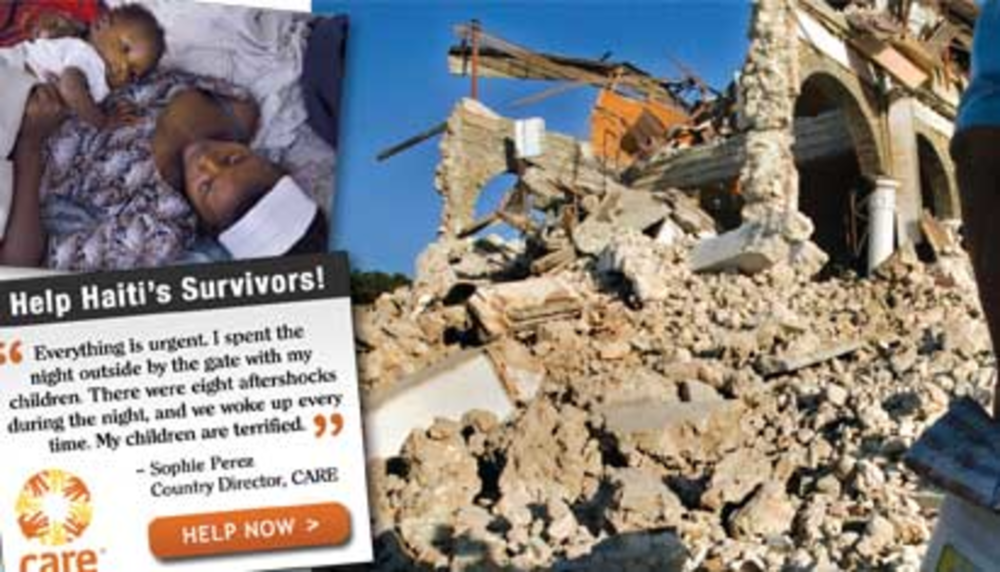As search engines add more social content by indexing Twitter and Facebook feeds and introducing tools like Google Buzz, online marketers are taking a more holistic approach to search marketing and integrating social media into their search optimization strategies.
“Social is one of those tactics that is becoming even more valuable because it is cross pollinating into search, and social threads are being indexed in search engine results,” says Robert O’Neil, director of online marketing and analytics at Tag New Media. “Communicating through Facebook and Twitter feeds now drives into the search space.”
For CARE, a nonprofit organization that combats global poverty, search marketing and social marketing allow the organization to react immediately to global emergencies with real time marketing campaigns. After the devastating earthquake in Haiti, CARE launched a social media initiative through its Twitter and Facebook accounts. It also optimized its natural and paid search after the crisis to raise money for disaster victims. The nonprofit’s digital agency, RedEngine Digital, handled the initiative.
If you searched on Google for “Haiti” in January, CARE came up in both paid and natural results, as well as in Google’s social indexing feed. All links directed visitors to a landing page where they could donate to or read about CARE’s efforts after the Haiti disaster.
“Social media is high on the list of areas of new strategic thinking about how to build awareness and galvanize supporters to give donations, especially during an emergency,” says Toby Smith, director of Web strategy at CARE.
“A lot of people found out about the earthquake from their social networks and from news sites,” he says. “They wanted to help so they went to Google and searched for which NGOs work in Haiti. The two channels worked together.”
The American Red Cross also used digital channels to raise money for Haiti. It raised $24 million in the first few days after the natural disaster through a text-to-donate-$10 mobile campaign, about a fifth of the nonprofit’s total Haiti-related funds.
Smith would not say how much money CARE raised for the Haiti relief effort, but he did say that emergencies tend to raise a lot more money than other periods. As of February 8, CARE reported that it had distributed food, water, hygiene kits and other survival tools to 143,027 people with the money.
CARE was able to mobilize this rescue mission quickly using social and search because of the real time nature of the emergency.
“The whole world was paying attention,” adds Smith. “The great thing about the Web is that it is where all the action is when there is an emergency.”
David Berkowitz, senior director of emerging media and innovation for agency 360i, notes that news items work well for marketers using search and social marketing because of the timeliness of the real-time results of topical subjects.
“If you have a hot topic or a breaking story, then you are more likely to have your Twitter feeds showing up in search, because it is the freshest content,” he says.
But Berkowitz warns that real time can be a challenge. While marketers expect variability in search engine optimization on a daily basis, he explains, real-time variability can means results can change by the minute, and it is up to the search engines to decide which content to include.
While CARE successfully tied search and social together to maximize results for Haiti, it normally takes a different approach to the taglines it uses in search landing pages vs. its social pages.
In general, search pages encourage consumers to donate and are more driven towards raising money. For example, the paid search link for the Haiti effort read “CARE is providing aid to earthquake victims in Haiti. We need your help,” with a landing page that read “Help us Save Lives and Rebuild in Haiti” and featured a large “Donate Now” button.
By contrast, its social pages are more focused on news and updates about their progress on the ground. A Twitter post read, “We’ve installed 35 latrines and are working on 135 more in Carrefour #haiti. In total @CARE will construct 1,000 latrines.” Only a couple of Tweets called for specific donations.
“Social media is about social connections for people, so we have tried not to do a lot of direct asks in Twitter and instead make engaging content about what is going on with care and poverty reduction,” Smith says. “We put out stories about policy actions and try to put out content that is relevant to the user rather than just asking for money. But search works well for donations because people want to give.”







